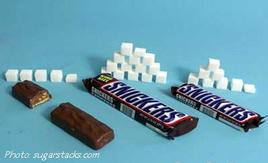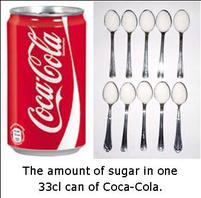WHY IS EXCESS SUGAR SO DANGEROUS?
Are you a sugarholic? There is no doubt that most of us cannot resist something that tastes sweet. So why is it that humans have this craving for sweetness, so much so that some people actually become addicted to it?
Are you a sugarholic? There is no doubt that most of us cannot resist something that tastes sweet. So why is it that humans have this craving for sweetness, so much so that some people actually become addicted to it?

A desire for sweet things is perfectly natural. It is, in fact, Nature’s way to make sure that we humans have sufficient vitamin C for our needs. For ancient man, the chief source of this vitamin would have been through eating fruit and the sweet taste would attract us to eat it. A few mammals in the animal kingdom cannot manufacture vitamin C in their own bodies and humans, along with guinea pigs, monkeys and apes fall into this category. At the same time as eating the fruit, various other important minerals and nutrients present in the skin also become available. What we were not designed to do was to strip off the skin and process the fruit so that only the concentrated sugar is left and this of course is what has caused so much grief in our modern society.
NO NATURAL APPETITE CHECK Sugar, in all its concentrated forms white or brown, is dangerous because when highly refined it can easily be consumed in great quantity. When eaten as whole sugar cane, as the cane cutters do in the countries where it is grown, the natural fibre content means that one cannot eat much of it and it is absorbed slowly in the human gut. However, when the sugar cane is refined to make crystalline sugar it is absorbed extremely quickly with no natural appetite check and is therefore all too often eaten in excess. To equal the amount of sugar in say two teaspoons of crystalline sugar added to a cup of tea or coffee, one would have to eat two whole apples. Excess glucose (the form in which sugar is ultimately absorbed) is converted into body fat. Over consumption is thus the principal cause of the widespread obesity which inevitably occurs in populations eating refined carbohydrates, and unfortunately, along with obesity goes diabetes. Surgeon Captain T.L.Cleave explained, “ the frequent occurrence of late onset diabetes (the commonest type) is exhaustion of the human body’s cellular mechanism for dealing with absorbed sugar. Repeated peaks of blood glucose absorbed at unnatural speed overwhelms and wears out the pancreatic insulin-producing cells.” LIGHTING THE FUSE Professor John Yudkin observed that people now eat, in just two weeks, the weight of sugar that 200 years ago would have taken a whole year to consume. Cleave compares the upsurge in sugar consumption with the lighting of a fuse, the length of which varies for different diseases. Appendicitis explodes immediately, diabetes in 20 years, coronary thrombosis in about 30 years and diverticular disease in 40 years. At long last, it has been generally accepted that it is not saturated fat that is the killer, but there is plenty of evidence to show what damage crystalline sugar can and continues to do. 
HIDDEN SUGAR IN FOOD AND DRINK
The National Diet & Nutrition Survey (NDNS) report, 26th June 2014, found that soft drinks are the biggest single source of added sugar for young people, with boys aged 11-18 getting 42% of their daily energy intake this way. A 33cl can of regular Coca-Cola or Pepsi contains 35g, or almost nine teaspoons of sugar. A study published in the BMJ estimates that sugar sweetened drinks may give rise to nearly 80,000 diabetes cases over 10 years in the UK. Processed food, cakes, biscuits and breakfast cereals almost all have too much sugar. Frosted Flakes, for example, contain 8.9 teaspoons of sugar per 100 grams and even Special K, a supposed healthy cereal, contains 3 teaspoons of sugar per 100 grams. DON’T BE FOOLED BY ARTIFICIAL SWEETENERS The worst measure anyone can take to reduce their sugar intake is to resort to artificial sweeteners as these can be far more damaging than sugar itself. Dr. Ralph G. Walton of the North eastern Ohio Universities College of Medicine is one of the leading researchers on aspartame. “The artificial sweetener aspartame is typically used to sweeten so-called "diet" foods and beverages in lieu of sugar or high fructose corn syrup, HFCS, the idea being that consuming fewer calories will result in weight loss. (Avoid products marketed as “reduced calorie,” “sugar-free,” and “diet,” that typically contain aspartame or other artificial sweeteners). However, research has completely demolished this notion, showing that artificial sweeteners actually have the converse effect; they lower appetite suppressant chemicals and encourage sugar cravings and sugar dependence, thereby raising your odds of unwanted weight gain. Research has also shown artificial sweeteners promote insulin resistance and related health problems just like ordinary sugar does”. Read also the associated article entitled :
"The Explosive Mix of Sodas, Sugar and Mineral Deficiencies". |
WHY HIGH FRUCTOSE CORN SYRUP IS DANGEROUS
The U.S. government subsidizes corn farms, meaning there are huge quantities of excess corn being produced which is used for everything from cattle feed to ethanol to the addictive high-fructose corn syrup (HFCS). In the '70s it became popular with the food industry after which its use increased 1000 fold. Now it is used world wide. American Dr. Mark Hyman in an article written in October 2014, describes the difference between HFCS and cane sugar. HFCS and cane sugar are NOT biochemically identical or processed the same way by the body. HFCS is an industrial food product and is far from “natural” or a naturally occurring substance. The sugars are extracted from corn stalks through a secret chemical enzymatic process resulting in this novel compound called HFCS. Cane sugar (sucrose) is made of two-sugar molecules bound tightly together, glucose and fructose in equal amounts. The enzymes in your digestive tract must break down the sucrose into glucose and fructose, which are then absorbed into the body. “HFCS also consists of glucose and fructose, not in a 50-50 ratio, but a 55-45 fructose to glucose ratio in an unbound form. Fructose is sweeter than glucose. Products with HFCS are sweeter and cheaper than products made with cane sugar. This allowed for the average soda size to balloon from 8 ounces to 20 ounces with little financial costs to manufacturers but great human costs of increased obesity, diabetes, and chronic disease. Since there is there is no chemical bond between them, no digestion is required so they are more rapidly absorbed into your blood stream. Fructose goes right to the liver; this is why it is the major cause of liver damage and causes a condition called “fatty liver” which affects 70 million people." The rapidly absorbed glucose triggers big spikes in insulin, the body’s major fat storage hormone. Both these features of HFCS lead to increased metabolic disturbances. “High doses of free fructose have been proven to literally punch holes in the intestinal lining allowing nasty byproducts of toxic gut bacteria and partially digested food proteins to enter your blood stream and trigger the inflammation that we know is at the root of obesity, diabetes, cancer, heart disease, dementia, and accelerated aging. Naturally occurring fructose in fruit is part of a complex of nutrients and fiber that doesn’t exhibit the same biological effects as the free high fructose doses found in “corn sugar”. SUPERMARKET FOOD CONTAINING HIGH-FRUCTOSE CORN SYRUP It is well known that sweet confectionery and soft drinks are full of high-fructose corn syrup, but here are some unexpected supermarket products that are likely to contain HFCS: Bread, mayonnaise, salad dressing, ice cream, tinned tuna, canned fruit and vegetables, crackers, cereals, ketchup, soup and yoghurt. In addition to sweetness, HFCS can greatly extend the shelf life of supermarket products. It often appears in ingredients lists as ‘glucose-fructose syrup’, ‘high fructose corn syrup’ or just HFCS. In his website newsletter of 3rd August 2015, Dr. Mercola refers to ‘One study found that fructose is readily used by cancer cells to increase their proliferation – it “feeds” the cancer cells, promoting cell division and speeding their growth, which allow the cancer to spread faster. Alzheimer’s disease is another deadly illness that can arise from too much sugar consumption. A growing body of research found a powerful connection between a high-fructose diet and your risk of developing Alzheimer’s disease, through the same pathway that causes type 2 diabetes.' REDUCE SUGAR INTAKE GRADUALLY
So what can be done? The best plan is to try to cut down gradually on your daily consumption of sugar. Reducing the amount of sugar in tea and coffee is relatively easy and try to avoid snacking between meals. Add a crushed banana to stewed fruit instead of sugar. Over time, instead of everything tasting of sugar, you will start to enjoy the individual taste of different foods. Honey, while nutritious, is still a concentrated sugar food to be eaten only as an occasional treat. The sugar industry has consistently attempted to prevent the public from being informed about the harmful effects of sugar. Besides concealing sugar’s health risks, the processed food industry has spent billions engineering processed food to be even more addictive. SUGAR TAX It was Dr. Walter Yellowlees, of the McCarrison Society, who in his book ‘A doctor in the Wilderness’, published in 1993, was one of the first to suggest that a sugar tax would be perfectly logical. “Most people accept that in the quantities in which it is consumed in the UK today, refined sugar is the main cause of dental decay and contributes to the causes of obesity. Both of these common diseases cost the taxpayers enormous sums of money; why should those who eat and produce sugar not help to pay its costs? If my calculations are correct, a tax of 2p per pound of sugar would yield over £100 million, assuming that the present per caput consumption is 100lb per annum.”
References: http://articles.mercola.com/sites/articles/archive/2014/12/23/artificial-sweeteners-confuse-body.aspx http://news.bbc.co.uk/2/hi/health/6933799.stm http://www.bbc.com/news/health-27941325 http://drhyman.com/blog/2011/05/13/5-reasons-high-fructose-corn-syrup-will-kill-you/ http://www.dailymail.co.uk/news/article-2337798/Are-sugar-addict-Scientists-say-high-fructose-corn- syrup-addictive-cocaine.html#ixzz3iQjiHW5D A Doctor in the Wilderness Walter Yellowlees ISBN 1-85756-013-2 |

